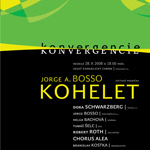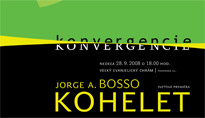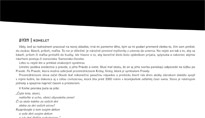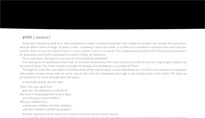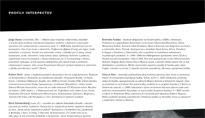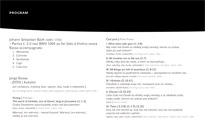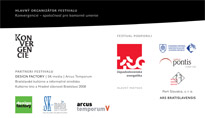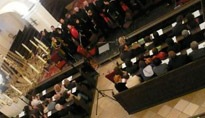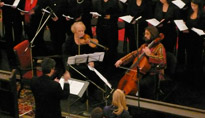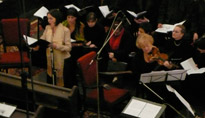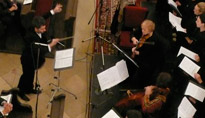jorge a. bosso
musician, composer, cellist
works_vocal_
קהלת
KOHELET
for solo violin, solo cello, reciting voice, soprano, bass and mixed choir (2006)
First performance: September 28th 2006, Evangelical Church, Bratislava, Slovakia
Dora Schwarzberg, violin
Jorge A. Bosso, cello
Robert Roth, reciting voice
Helga Bachová, soprano
Tomás Šelc, bass
Chorus Alea
Branislav Kostka, conductor
Duration: 60’
Prologo
The word of Kohelet, son of David, king in Jerusalem (1/1-2)
(mixed choir, violin, violoncello)
Parte Prima
I. What does man gain (1/3-9)
(reciting voice, violin, violoncello)
II. All streams run to the sea (1/7)
(choir sopranos and altos, violin, violoncello)
III. All things are full of weariness (1/8-11)
(aria solo soprano, violin)
IV. I Kohelet (2/10-11)
(reciting voice, solo violin)
V. Choral I (2/22-23)
(mixed choir)
VI. Time ( 3/2-8) (1/1-2) (3/15)
(solo soprano, solo basso, mixed choir, violin, violoncello)
Again I saw (Fuga) (4/1-3) (1/2)
(mixed choir, violin, violoncello)
Parte seconda
VII. Choral II (6/11-12)
(mixed choir)
VIII. Consider the work of God (7/13-24)
(reciting voice, solo violoncello)
IX. But all this I laid to heart (9/1-3)
(aria solo basso, violoncello)
X. For the living know that they will die (9/5-7) (1/1-2) (3/15)
(solo basso,choir tenors, bass, violin, violoncello)
Epilogo
The word of Kohelet, son of David, king in Jerusalem (1/2) (12/7-8) (12/1-5) (12/9-12, reciting voice) (12/6-8) (3/15) (6/11-12)
(reciting voice, solo soprano, solo basso, mixed choir, violin, violoncello)
Every time I decide to work on a new composition it takes me quite a long time until I begin to translate into sounds the experience through which I went through. A poetry, a tale, a painting. It does not matter. It is difficult to transform a creation from one field into another. And it is not even about render in music a poem, a story or a canvas. The consequence should be the result of an assimilation, an absorption and finally a proposal of a point of view, an statement.
One’s statement. Because it is not just an intersemiotical translation.
The artist gives his testimony of the truth, of his Truth of the world. The artist must be sure that he and his creation give answers to the wish of Truth. The Truth revealed through the Beauty, and the Beauty as a symbol of Truth.
Through the word the man began to interlace that infinite web of ideas, visions that almost by a miracle it can connect us nowadays with another human being, with an entire culture that lived two thousands years ago in any remote point of the world. The word as an instrument of union through time and space.
In the book of Joel, we can read:
“Hear this, you aged men,
give ear, all inhabitants of the land!
Has such a thing happened in your days,
or in the days of your fathers?
Tell your children of it,
and let your children tell their children,
and their children another generation.”
Kohelet represents at the same time a point of arrival and an infinite source.
“… one work, one action, a rare illumination, just one creation: it will live, because no posterity will be able to live without it ” wrote Nietzsche on 1874.
Along the centuries a huge amount of books, thoughts, ideas surrounded The Ecclesiastes.
“ A book must be like an axe to break the iced sea that is inside us ” expressed Kafka. This is what the truth of the Preacher signifies to me. I am not the same after having read these lines. Few lines. Approximately one percent of the whole Bible.
Essential.
Vital.
Necessary.
“By building bridges into the future we must take care not to burn the bridges connecting today’s culture to its immortal past” , whispered Dmitri Shostakowitsch.
It is without doubt an expression that carries in itself a big truth.
Every artistic creation is in close relation with its time and carries in itself a heritage that goes beyond its own nature.
And every true artist is situated in an intersectional point between an acquired heritage, his present and a tomorrow that he elaborates himself through a unique and personal path.
The heritage, the legacy should never be forgotten, and that primarily it is part of a cultural patrimony that brings in itself a lonely dialogue with the Divine in his research for a superior level of existence from the individual nature towards the collective one, that is in itself the utmost aim of art.
Jorge A. Bosso
